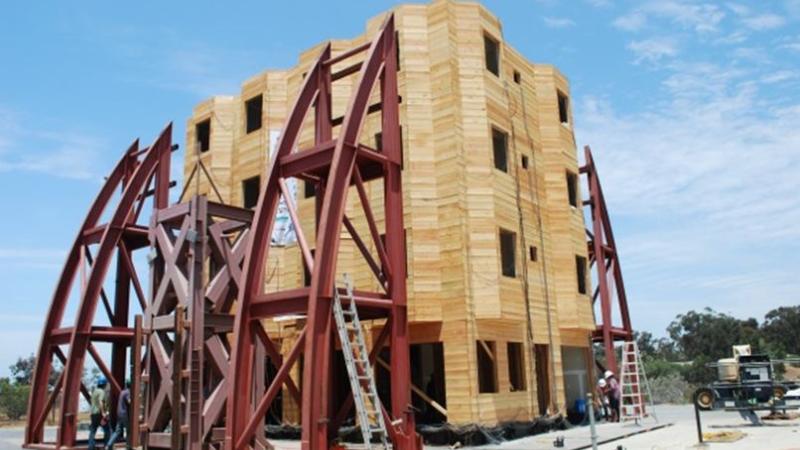January 21, 2014

(Rensselaer civil engineering doctoral student Jingjing Tian iwrote this post about her experience at a huge shake-table experiment she and her adviser, Professor Michael Symans, attended last year. They are part of a multi-university research project dedicated to making buildings more resilient to earthquakes.)
http://www.youtube.com/watch?v=paQFaQj15Uc
A full-scale, multi-story wood-framed building with soft ground story was constructed and tested during this past summer at the NEES (Network for Earthquake Engineering Simulation) Laboratory at the University of California, San Diego (UCSD), as part of the NSF-sponsored NEES-Soft project. The project focuses on seismic performance of multi-story buildings with weak (soft) ground stories. The test specimen was designed and constructed to resemble the architectural and structural characteristics of soft-story residential buildings located in high-seismicity regions of the western United States (see a comparison below).
This type of construction is categorized as “soft” because the ground story is typically utilized as either garage space or commercial space and thus has large window/door openings and relatively few interior walls as compared to the upper-stories. Overall, the ground story is much weaker than the upper stories, resulting in it being defined as “soft” in terms of strength and “flexible” in terms of stiffness. In addition, the walls in the ground story are irregularly distributed such that the entire building is prone to simultaneous lateral and twisting motion when subjected to earthquake ground shaking.
To address the vulnerability associated with soft-story structures, five universities and various industry partners were brought together to form the NEES-Soft project, wherein different types of retrofits have been designed and tested using historical earthquake ground motions. In addition, the un-retrofitted structure was tested to evaluate its potential for collapse. Special attention was given to introducing a sufficient amount of retrofit in the soft ground story to achieve a pre-defined performance objective, while at the same time minimizing the requirement for retrofit and post-earthquake repair in the upper stories.
The multi-university project is led by Colorado State University (CSU), with participants from Rensselaer, Cal-Poly Pomona, Clemson University, and Western Michigan University.
The research team at Rensselaer (led by me, with supervision by Professor Michael Symans and assistance from graduate student Steve Yang), focused on the design and installation of an energy dissipation (damping) system within the ground story. The system consists of seismic dampers that, under cyclic motion, dissipate energy from the earthquake, and thereby reduce the energy dissipation demand on the lateral force resisting elements (shear walls) of the structure. Without the energy dissipation system, the shear walls would absorb the earthquake energy via nonlinear inelastic behavior and become damaged. The dampers that were used in the tests were installed in a special steel frame that, through its geometry, provided amplification of the damper stroke, thus increasing the energy dissipation capacity of the dampers. You can see these dampers below.

Professor Michael Symans from RPI (right) and Professor John van de Lindt from CSU (left) install a damper frame on the ground story of the test specimen.
Two earthquake ground motions were used in the shaking table tests. These ground motions were recorded during the 1989 Loma Prieta, CA Earthquake (Gilroy record) and the 1992 Cape Mendocino, CA Earthquake (Rio record). The motions were scaled to different seismic intensities to represent the Design-Basis Earthquake (DBE – occurs approximately once every 500 years and thus is a rare event) and the Maximum Considered Earthquake (MCE – occurs approximately once every 2500 years and thus is a very rare event). A smaller seismic test was performed prior to the large seismic tests to check the operation of the measurement sensors (338 channels) attached to the building and the damper frames.
The testing was a great success! The energy dissipation system behaved as expected (based on numerical simulations conducted prior to testing), limiting the maximum deformations of the walls in the soft ground story to about one inch for the MCE-level shaking. Under such deformations, there was no observable damage to the walls. This was validated by the experimental test data that showed no significant changes to the dynamic properties (natural period and mode shapes) of the structure. Not only were the wall deformations small for such large seismic loads but due to the strategic placement of the damper frames, the twisting response was essentially eliminated. See some video footage of the shoot below:
http://www.youtube.com/watch?v=jtmS0uJE_XM
http://www.youtube.com/watch?v=H94Q1e9lKsg
Overall, the UCSD shake-table testing component of the NEES-Soft project was very successful. The soft-story vulnerability was addressed via experimental application of different seismic retrofit techniques along with validation of their associated numerical models. In addition, the potential for collapse of an un-retrofitted soft-story building was evaluated via testing up to a collapse condition. Application of these retrofits to existing structures will go a long way toward ensuring that people living in such buildings, along with their property and the building itself, will be well protected in future earthquakes. This project would not have been such a success without the collaboration of many individuals including faculty members, graduate and undergraduate students, industry partners, advisory boards, laboratory staff and government officials.

Group photo taken on final day of testing at UCSD-NEES Laboratory. RPI participants include graduate student Jingjing Tian (front row, second from right), Professor Michael Symans (back row, third from right), and graduate student Steve Yang (back row, rightmost).
This research was supported by the National Science Foundation under Grant No. CMMI-104163 and 1314957. Any opinions, findings, and conclusions or recommendations expressed in this post is my own and do not necessarily reflect the views of NSF.


